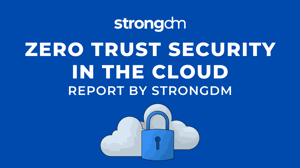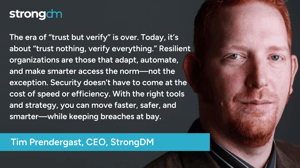How to Implement Zero Trust (Step-by-Step Guide)


Written by
Fazila MalikLast updated on:
October 17, 2025Reading time:
Contents
Built for Security. Loved by Devs.
- Free Trial — No Credit Card Needed
- Full Access to All Features
- Trusted by the Fortune 100, early startups, and everyone in between
The Zero Trust security framework is rapidly being adopted by organizations as a way to fortify access management. A report by Cisco indicates that more than 86% of organizations have already begun implementing it.
However, applying Zero Trust security successfully is entirely dependent on having a thoughtful, informed, well-managed Zero Trust implementation plan. Sloppy or rushed attempts to deploy Zero Trust result in patchy security at best, and regular cyberattacks at worst.
In this blog, we’ll offer a blueprint for how to implement Zero Trust security effectively to help your organization initiate and manage access management for all your users, devices, and resources.
The 5 Pillars of Zero Trust
Let’s start by defining the concept of Zero Trust based on its essential pillars. The Zero Trust Maturity Model (ZTMM) created by CISA outlines five key pillars that form the foundation of a Zero Trust architecture. These pillars guide organizations in implementing and optimizing secure principles in their IT environments. You can implement these pillars on your own, or partner with StrongDM to help you meet CISA identity and access-related requirements, network requirements, and ZTMM growth.
Here's a summary of each pillar:
- 1. Identity: This pillar focuses on ensuring that the identity of every user accessing the system is verified and authenticated. It is about managing user identities and credentials and enforcing strong authentication methods so only authorized users can access resources.
- 2. Devices: The Devices pillar concerns the security of all devices accessing the network, including personal and organization-owned devices. It involves managing device access, ensuring that they are secure and compliant with security policies, and continuously monitoring their state.
- 3. Networks: Securing network communications is a critical element of security and the Network pillar guides organizations in how to limit lateral movement within the network. Success begins by creating micro-segments within the network to control access and applying security controls based on the principle of least privilege to reduce the attack surface and limit potential damage from breaches.
- 4. Applications and Workloads: This focuses on securing applications and workloads, regardless of where they are hosted (on-premises, cloud, or hybrid environments). It includes the management of permissions, securing Application Programming Interfaces (APIs), and ensuring that applications are regularly updated and patched.
- 5. Data: The final pillar centers on protecting data. This involves classifying data based on sensitivity, enforcing access controls, and applying encryption for data at rest and in transit. The goal is to ensure that data is only accessible by authorized entities and is protected from unauthorized access and leaks.
Together, these pillars address the building blocks and critical elements – cybersecurity policies, procedures, automation, and orchestration – that constitute an effective and mature Zero Trust architecture.
How to Implement Zero Trust Security: 10 Steps
With a clear understanding of the five pillars of Zero Trust and your organizational security goals in mind, you can start acting on your Zero Trust implementation plan. These 10 steps offer a roadmap for using Zero Trust principles effectively as the basis for your organization’s security posture.
Step 1: Assess the People, Devices, and Apps that Will Access the Network
The first step in implementing Zero Trust is to identify and assess all the network’s users, their roles, and the devices they use, as well as the applications and services they need to perform their tasks. This assessment will help you understand the scope of your Zero Trust implementation and ensure that you match the right security protocols and restrictions with the right users, roles, and devices. Take a shortcut, and use our role and access discovery workbook.
Step 2: Prioritize Processes and Break Down Zero Trust Implementation Into Phases
Implementing Zero Trust can be a complex undertaking, especially for large organizations. To make it more manageable, start by prioritizing the areas of the business and the data that are most vulnerable and break down the implementation into phases. Start with the most critical areas and gradually expand the scope. This phased approach allows you to take a measured approach, accomplishing what you can with the resources you have, rather than trying to tackle everything at once, which will tax the security team with an onerous set of tasks and deadlines.
Step 3: Determine Technological Needs to Fill in Security Gaps and Invest Accordingly
While implementing Zero Trust, it's essential to identify any security gaps in your current infrastructure that technology can address—and then invest where necessary. This may include upgrading your authentication systems, purchasing or switching identity providers, developing or purchasing a privileged access management tool, or deploying advanced monitoring and detection tools.
Step 4: Establish Strong Authentication and Access Controls
Authentication is a fundamental aspect of a Zero Trust implementation plan. Security teams need to establish strong authentication mechanisms such as multi-factor authentication (MFA), passwordless authentication, and single sign-on (SSO) to verify and protect the identity of users and devices.
Combining different aspects of authentication like strong passwords, biometrics, or security tokens will enhance the security of your authentication process. StrongDM recommends using the Authentication, Authorization, and Accounting (AAA) framework to maintain network security. Additionally, security teams should implement rigorous access controls to ensure that users only have access to the resources they need, following the principle of least privilege.
Step 5: Establish Least Privilege Access
Least Privilege Access is a critical component of Zero Trust. It is built on the principle of restricting user and device access to only the resources necessary for each person’s role and responsibility when they need it. One way to do this is to implement Just-in-Time access to all resources and reach Zero Standing Privileges to your most sensitive environments. Regularly review and update access permissions to align with the changing needs of your organization.
And it doesn’t have to be complicated — StrongDM makes it easy for the end user to request and receive access across all your infrastructure through access workflows so you can reduce the attack surface while giving team members the resources they need. The StrongDM platform makes it easy to analyze the configuration and optimization of access with StrongDM’s comprehensive reports library.
Step 6: Implement Micro-Segmentation for Network Security
Micro-segmentation, in this context, is the process of dividing your network into smaller, isolated environments for different applications and data. Micro-segmentation, restricts lateral movement within the network, making it harder for attackers to operate at-will if they gain access to a specific area. This adds an extra layer of security and limits the potential damage of an attack.
Step 7: Set Up Monitoring and Detection
By implementing a robust monitoring system that can detect any suspicious activities or anomalies on your network in real-time, you’ll have consistent insights into unexpected or unusual activity across your environment. Use intrusion detection and prevention systems, log analysis tools, and security information and event management (SIEM) solutions to identify and respond to potential security incidents promptly.
Step 8: Train Employees on Zero Trust Principles, Policies, and Best Practices
Employee vigilance plays a significant role in maintaining a secure environment. Educate and train them on Zero Trust principles, policies, and best practices so they understand the importance of strong authentication, least privilege access, and the role they play in protecting sensitive data. Regularly reinforce these principles through training programs, phishing “tests,” and awareness campaigns.
Step 9: Measure the Success of Your Zero Trust Implementation
Even with all of these sophisticated strategies in place, it will be difficult to know how successful your implementation was without a system of measurement. Define key performance indicators and monitor metrics such as reduction in standing access, improved grant utilization, the detection of suspicious activities, and the reduction in security incidents.
Regularly evaluate these metrics and use them to refine your implementation and make necessary adjustments. StrongDM has an out-of-the-box Reports Library that shows exactly the percentage of outstanding grants being utilized, sends alerts for long running sessions, and identifies specific users who have standing access to resources and apps.
Step 10: Roll Out Additional Phases of Zero Trust Implementation
Zero Trust implementation is an ongoing process. Once you have successfully implemented the initial phases, continue to expand your Zero Trust strategy by gradually rolling out additional phases and extending the scope of Zero Trust to cover more areas of your network.
Choosing the Right Solution for Your Zero Trust Implementation
Implementing Zero Trust requires choosing the right tools and technologies. Evaluate various solutions available in the market, considering factors such as scalability, compatibility, and ease of integration with your existing infrastructure. Look for a vendor that offers a comprehensive Zero Trust solution and provides excellent support and training resources.
Now that you know how to implement Zero Trust security, what’s the next step?
Make your Zero Trust implementation easy by using StrongDM for secure privileged access on-premises and in the cloud. Enable fast, intuitive, and auditable access to your entire technical stack for every member of your team.
Want to learn more? Get a no-BS, 14-day demo of StrongDM.
Next Steps
StrongDM unifies access management across databases, servers, clusters, and more—for IT, security, and DevOps teams.
- Learn how StrongDM works
- Book a personalized demo
- Start your free StrongDM trial

Categories:

About the Author
Fazila Malik, Sales Enablement Expert, as an accomplished Product Marketing Manager in the technology industry with over 5 years of experience, Fazila transitioned to a Sales Enablement leader position passionate about empowering go-to-market teams to excel in their roles. Throughout her career, she has worked with a range of technology products, including software applications and cloud-based solutions. Fazila is a member of the Product Marketing Alliance and an AWS Cloud Certified Practitioner. To contact Fazila, visit her on LinkedIn.
You May Also Like




